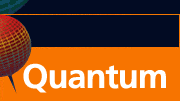CONTACTS
 |


Quantum Initiative: Quantum Lunch
The Quantum Lunch is regularly held on Thursdays in the Theoretical Division Conference Room, TA-3, Building 123, Room 121.
The organizing committee includes Malcolm Boshier (P-21), Lukasz Cincio (T-4), Diego Dalvit (T-4), Changhyun Ryu (P-21) , Nikolai Sinitsyn (T-4), Rolando Somma (T-4), Yigit Subasi (T-4), Christopher Ticknor (T-1), and Wojciech Zurek (T-4).
For more information, or to nominate a speaker, contact Yigit Subasi or Lukasz Cincio.
To add your name to the Quantum Lunch email list, contact Amanda Martinez.
Thursday, August 2, 2018
12:30 PM - 2:00 PM
Speaker: Justyna Zwolak (NIST)
Technical Host: Yigit Subasi
TOPIC: QFlow lite: Applying Machine Learning to Quantum-Dot Experiments
Abstract
There are a myriad of quantum computing approaches, each having its own set of challenges to understand and effectively control their operation. For semiconductor-based methods (e.g., coupled quantum dots), control is provided by electrostatic confinement, band-gap engineering, and input voltages on nearby electrical gates. Currently, heuristics are used to set the input voltages in order to reach a stable few electron configuration. It is desirable, however, to have an automated protocol to achieve a target electronic state, especially as the size of the system is scaled up.
In recent years, machine learning has emerged as a "go to" technique for image recognition and other tasks. It can give reliable results when trained on robust and comprehensive data. We show how convolutional neural networks (CNNs) can be trained to recognize the electronic state within quantum dot arrays. We find ~95% agreement between the CNN characterization and the Thomas-Fermi model predictions for nanowires. Using optimization techniques, such trained networks can be then implemented to automatically tune the device to desired dot configuration without the human intervention. I will discuss how different data (i.e., current through the quantum dots versus charge sensor readout) affects the performance of the CNN, as well as our recent findings for tuning the quantum dot device to a specific charge configuration. This machine learning approach gives opportunities for the control of quantum dot devices as they scaled to larger and larger arrays necessary for computing and fundamental applications.
|


